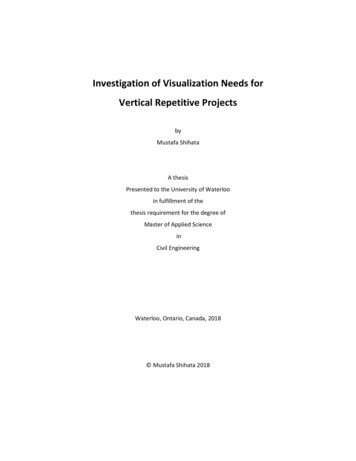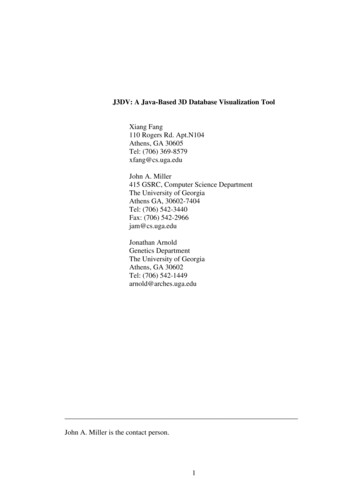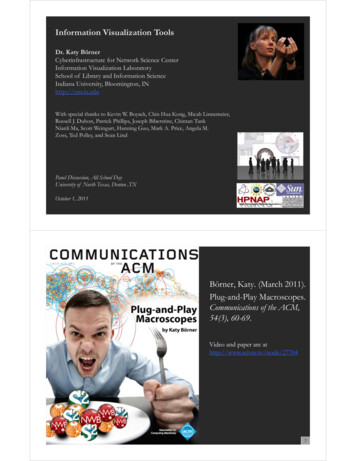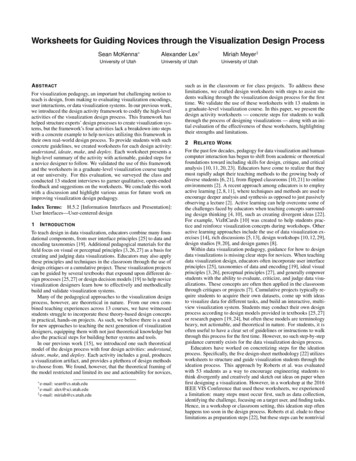
Transcription
Investigation of Visualization Needs forVertical Repetitive ProjectsbyMustafa ShihataA thesisPresented to the University of Waterlooin fulfillment of thethesis requirement for the degree ofMaster of Applied ScienceinCivil EngineeringWaterloo, Ontario, Canada, 2018 Mustafa Shihata 2018
Author’s DeclarationI hereby declare that I am the sole author of this thesis. This is a true copy of the thesis,including any required final revisions, as accepted by my examiners.I understand that my thesis may be made electronically available to the public.ii
AbstractRepetitive construction projects, particularly high-rise buildings, are complex projects thatsuffer from cost overruns and delays. For these projects, efficient repetitive schedulingbecomes necessary. Repetitive scheduling, however, remains less utilized in the industry duemainly to its visualization challenges. In an effort to improve schedule visualization, this thesissurveys available software packages for scheduling repetitive and non-repetitive projects andsummarizes the visualization challenges for high-rise buildings.To improve schedule visualization, a new visualization method, Activity Continuity on TimeInclined Visual (ACTIV), has been developed in this thesis. ACTIV changes the typical slantedlines of the repetitive schedule into vertical lines that resemble the shape of the high-risebuilding. The main concept is to represent the time-axis at an angle, rather than the typicalhorizontal orientation. To incorporate many activities, the time-axis angle is calculateddifferently for each activity. Based on the results of using ACTIV on a case study project, itsinteresting capabilities include better scheduling of structural core activities presenting thetime-axis on an activity-dependent angle and producing legible schedule reports.Recommendations for adapting the proposed method to other types of repetitive projectsare made.iii
AcknowledgmentAll praise and gratitude be to God, for it is only his grace that good deeds are accomplished.I would like to express my deepest gratitude to all those who helped me in accomplishing myMaster Thesis. I would like to express my wholehearted thanks to my supervisor Prof. TarekHegazy for his excellent guidance, patience and providing me a comfortable atmosphere fordoing my Master Thesis. I would also like to thank the readers, Prof. Hassan Baaj and Prof.Chris Bachmann, for their time and their useful comments.Finally, I must express my very profound gratitude to my beloved mother and inspiring fatherfor providing me unbiased support and continuous encouragement throughout my years ofstudy and through the process of reaching and writing this thesis. This accomplishment wouldnot have been possible without them. Also, many thanks to my siblings who always stood byme in a difficult time and to all my dear friend for sharing their knowledge during theinterviews in the field study.iv
Table of ContentsAuthor’s Declaration . iiAbstract . iiiAcknowledgment. ivTable of Contents . vList of Figures. viiiList of Tables . xiChapter 1 Introduction . 11.1 General . 11.2 Research Objective and Scope . 21.3 Research Methodology . 31.4 Thesis Organization . 4Chapter 2 Literature Review. 52.1 Introduction . 52.2 Types of Repetitive Projects . 52.3 Scheduling of Repetitive Projects . 62.3.1 Critical Path Method (CPM) for Repetitive Schedule . 62.3.2 Line of Balance (LOB) . 82.3.3 Linear Scheduling Model (LSM) . 102.4 Research on Repetitive Scheduling . 132.5 Conclusion . 16Chapter 3 Comparing Recent Applications for Non-Repetitive Scheduling . 183.1 Introduction . 183.2 Comparison Criteria. 183.3 Overview of Existing Commercial Software . 193.3.1 Primavera . 193.3.2 Microsoft Project . 223.3.3 UDA Construction-Suite. 243.3.4 PROCORE . 263.3.5 Candy . 28v
3.3.6 Buildertrend. 303.3.7 BIM 360 . 313.3.8 e-Builder . 333.3.9 GenieBelt . 353.3.10 Jonas Premier . 363.4 Comparison of the Ten Non-Repetitive Software Systems . 373.5 Conclusion . 38Chapter 4 Comparison of Recent Applications for Repetitive Scheduling . 394.1 Introduction . 394.2 Comparison Criteria. 394.3 Overview of Top Repetitive-Scheduling Software. 394.3.1 Spider Project Version 10 . 404.3.2 ChainLink Version 5 . 434.3.3 TimeChainage Version 8.2 . 454.3.4 TILOS Version 7 . 474.3.5 ASTA Powerproject Version 14. 494.3.6 VICO Version 5D . 514.3.7 LinearPlus Version 2.1 . 534.4 Comparison of Seven Repetitive Scheduling Software . 554.5 Conclusion . 56Chapter 5 Improved Schedule Visuals for Vertical Repetitive Projects. 575.1 Introduction . 575.2 Visual Challenges in High-Rise Buildings . 575.3 A New Visual Representation of the Schedule . 585.3.1 Case Study . 595.3.2 ACTIV Schedule for Activity Group with Single Crew . 605.3.3 ACTIV Schedule for Next Group (Single Crew) . 625.3.4 ACTIV Schedule Next Group (Multiple Crews) . 645.3.5 ACTIV Reports . 705.4 Validation. 72vi
5.5 Conclusion . 72Chapter 6 Conclusion . 736.1 Summary and Conclusion . 736.2 Research Limitations . 746.3 Future Research. 74References . 75vii
List of FiguresFigure 1.1 Research Methodology . 4Figure 2.1 Types of Repetitive Scheduling . 5Figure 2.2 CPM Network with Logical Relationships . 7Figure 2.3 CPM Network for Multi-Storey Building . 7Figure 2.4 LOB Schedule for High-Rise Building Project . 9Figure 2.5 LSM Schedule for a Highway Project (Based on Harmelink, 1995) . 11Figure 2.6 Activity types in Linear Scheduling Model (Based on Spencer & Lewis, 2005) . 12Figure 3.1 Activities and Resource Information in Primavera . 20Figure 3.2 Different Views of Resource Assignment or Allocations from Primavera . 20Figure 3.3 Multiple Reporting from Primavera . 21Figure 3.4 Activities Entered into a Work Breakdown from Microsoft Project . 22Figure 3.5 Resource Report from Microsoft Project . 23Figure 3.6 Dashboard from Microsoft Project . 23Figure 3.7 Enter Activities into a Work Breakdown from UDA Construction-Suite . 24Figure 3.8 Cost Estimating Report from UDA Construction -Suite . 25Figure 3.9 Project Overview from Procore . 26Figure 3.10 Project Schedule Shown on a Calendar Chart . 27Figure 3.11 Work Breakdown Structure and Bar Chart . 28Figure 3.12 Earned-Value Management (EVM) Report from Candy . 29Figure 3.13 Activity Entered into a Work Breakdown from Buildertrend . 30Figure 3.14 Activities, Work Breakdown Structure, and Bar Chart . 31Figure 3.15 Planning and Schedule Project from BIM360 . 31Figure 3.16 Multiple Reporting in BIM360 . 32Figure 3.17 Enter Activity into a Work Breakdown from e-Builder . 33Figure 3.18 e-Builder Work Flow Diagram . 34Figure 3.19 Cost Estimation Report from e-Builder . 34viii
Figure 3.20 Color-Coded Activities with Resource Photos . 35Figure 3.21 Activities and Bar Chart. 36Figure 4.1 Spider Project Shows Network Linked Critical Path Float . 40Figure 4.2 Defining Project Resources . 41Figure 4.3 Linear Schedule and Crew Details . 41Figure 4.4 Progress Information, Resource Profile, and Cash Flow . 42Figure 4.5 Risk Analysis . 42Figure 4.6 Defining Activities in ChainLink . 43Figure 4.7 ChainLink Chart for a Road Project (Linear Scheduling) . 44Figure 4.8 Time Chainage Input Activity Information . 45Figure 4.9 TimeChainage Schedule for a Road (Linear Schedule) . 46Figure 4.10 TimeChainage Chart for a Multi-House Scattered project . 46Figure 4.11 Various Reports on the Planned Versus Actual Schedule . 46Figure 4.12 TILOS Data Entry . 47Figure 4.13 TILOS Resources and Costs . 47Figure 4.14 TILOS Linear Schedule for a Road Project . 48Figure 4.15 Defining Activities in ASTA Powerproject . 49Figure 4.16 ASTA Powerproject Shows Flow Line Representation . 50Figure 4.17 ASTA Powerproject Reports . 50Figure 4.18 VICO Shows Network Linked Critical Path Float . 51Figure 4.19 VICO Chart for a High-Rise Project. 52Figure 4.20 Integrated 3D Model with Planning Schedule in VICO . 52Figure 4.21 LinearPlus Showing Network Linked Critical Path in the Schedule . 53Figure 4.22 LinearPlus Chart for a Road Project (Linear Scheduling) . 54Figure 5.1 3D Vertical Structure Problem . 58Figure 5.2 Corrected Schedule for Structural Core Activities . 58Figure 5.3 Basic Idea Behind the Proposed Schedule Visualization . 59Figure 5.4 3D model of the Case Study . 60ix
Figure 5.5 Proposed “Activity Continuity on Time-Inclined Visual (ACTIV)” ScheduleRepresentation . 61Figure 5.6 3D Model Displays the Process of ACTIV Schedule Model for Core Activities . 62Figure 5.7 2nd Group Does Not Show Vertical when Using the ( ) of the First Group . 63Figure 5.8 ACTIV Schedule Model for Second Group of Activities . 63Figure 5.9 ACTIV Schedule Model with Group 3 That Has Two Crews . 64Figure 5.10 ACTIV Schedule with Revised Time-axis Angle . 65Figure 5.11 ACTIV Schedule Model with Separate Crews . 66Figure 5.12 ACTIV Schedule with Tiling/Flooring Activity . 67Figure 5.13 ACTIV Schedule with the Doors Activity . 68Figure 5.14 Final ACTIV Schedule . 69Figure 5.15 Floor-by-Floor Report . 71x
List of TablesTable 2.1 Research Summary on Repetitive Scheduling . 14Table 3.1 Evaluation Criteria for Project Management Software . 18Table 3.2 Comparison Software Features Evaluation Criteria . 37Table 4.1 Evaluation Criteria for Repetitive Scheduling Software. 39Table 4.2 Comparison Software Features Evaluation Criteria . 55Table 5.1 Activities, Durations and relationships within each floor . 59Table 5.2 Activity-by-Activity Report . 70xi
Chapter 1Introduction1.1 GeneralRepetitive construction projects incorporate a number of repetitive units (e.g., floors, roadsections, multiple house) and can generally be categorized into non-linear and linear. Nonlinear repetitive projects contain high-rise buildings (vertical) and projects with scatteredunits such as housing projects and multi-bridge rehabilitation projects. On the other hand,the characterization of the linear repetitive projects are resembled by horizontal geometriclayout namely pipelines, railroad, and highways construction projects (El-Rayes & Moselhi,2001) .A construction project might contain both non-repetitive and repetitive activitiessimultaneously. High-rise buildings are an example of this case, where excavation andunderground works are non-repetitive tasks, done only once, followed by repetitive typicalfloors. The nature of repetitive projects offers significant savings on cost and time. There arenumerous benefits that can be achieved by maintaining crew-work continuity to achieve agood learning momentum (also known as learning-curve effect) that results in time and costsavings (Bakry, Moselhi, & Zayed, 2013). However, managing and planning a repetitiveschedule with crew-work continuity can be challenging (Bakry et al., 2013). Using traditionalscheduling techniques for non-repetitive projects, like the critical path method (CPM), toschedule repetitive projects has been commonly disapproved (Arditi, Asce, Tokdemir, & Suh,2002; Hegazy, Asce, & Kamarah, 2008; Hegazy & Wassef, 2001; Reda, 1990; Russell & Wong,1993). CPM does not compute or display productivity rates, tasks locations, and the resultingschedule does not legibly depict, visually, the large amount of data related to repetitiveprojects.1
Repetitive schedules are very challenging to show the large amount of data related torepetitive units, crews, and productivity rates. The common bar charts are incapable ofdisplaying actual location and progress rate (Duncan and Alvord, 2017). While it is possible tocreate copies of the tasks of one location and create a large bar chart of all the tasks in alllocations, the bar chart becomes huge (e.g., a 30-section highway with 15 typical activitiescreates a 450-activity bar chart). As such, a bar chart is severely limited when it comes tovisualizing a repetitive schedule as it cannot show which crew(s)/task(s) are fast or slow, andalso makes it harder to spot the overall construction philosophy (Duncan and Alvord, 2017).Despite large theoretical advancements in repetitive scheduling methods, the existence oftheir implementation has been limited in the US construction industry (Lucko et al., 2014).Duffy et al (2012) reported that this family of promising scheduling methods has not beenactively used in practice. Yamı ́n and Harmelink (2001) discussed the reasons for the wide useof bar charts in repetitive highway construction being its ease of use, good communication,and the general unawareness about repetitive scheduling methods. In a survey among 25professionals and researchers, Boton et al (2013) reported that as compared to bar charts,linear planning was known by only 32% of respondents and used by only four percent.With the recent advances in software and mobile apps related to project management, manydifferent ways of visualizing data have emerged. There is a need, therefore, to investigate thecurrently available tools to determine the best features that can provide the best planningtools for the repetitive and non-repetitive project. Also, there is a need for a better way tovisualize the schedule to make it more legible and easily understood by all project parties.1.2 Research Objective and ScopeThe primary objectives of this research are as follows:1. Conduct a survey of recent commercial applications for project management andaccordingly examine their advantage and limitations particularly on the schedulevisualization side;2
2. Conduct an extensive survey of recent repetitive scheduling software for projectmanagement and accordingly examine their advantages and limitation particularlyon the visualization side; and3. Document the most useful visualization features needed for repetitive and nonrepetitive projects and recommend improvements to existing visualization methodsto improve the liability of the schedule and manageability of repetitive projects,particularly high-rise building.1.3 Research MethodologyThe research methodology is shown in Figure 1.1 as follow:1. Conduct extensive literature review of the technical methods used to scheduleprojects and provide a critique of their visualization features that confuse therepetitive scheduling process;2. Conduct an extensive review of the literature mainly addressing areas of scheduling,accelerating and optimizing repetitive construction projects;3. Study repetitive and non-repetitive scheduling methods and their visualizationneeds;4. Utilize new commercial applications for project management;5. Utilize new repetitive scheduling software for project management;6. Recommend better visual application to facilitate better management of theproject;7. Suggest visual improvements for vertical repetitive projects;8. Implement a case study for the vertical scheduling section.3
Literature reviewSurvey of recent commercial apps for projectSurvey of recent repetitive software for projectRecommend visual featuresAnalysis of repetitive schedulesSuggest new visual chartsCase studyFigure 1.1 Research Methodology1.4 Thesis OrganizationThis thesis is presented in six chapters. The second chapter presents a comprehensiveliterature review. It focuses on existing tools and techniques for optimized scheduling ofrepetitive projects, and challenges with visualization for scheduling. Finally, chapter two endsby highlighting the identified gaps in the literature. The third chapter explains in detail thecomparison among recent applications for non-repetitive scheduling. Chapter four discussesthe comparison of current apps for repetitive scheduling. Chapter five suggests visualimprovements for vertical repetitive projects. Chapter six is the thesis conclusion andrecommendations for extensions to existing research delay analysis, recommended practicesand proposed standards.4
Chapter 2Literature Review2.1 IntroductionThis chapter presents a comprehensive literature review of the scheduling domain forrepetitive and non-repetitive construction projects. This chapter is divided into four mainsections. The first section discusses the main type of repetitive construction project. Thesecond section introduces the basic repetitive scheduling methods. The third section presentsrecent research on repetitive scheduling. Then, the last section presents the challenges withthe schedule visualization in repetitive projects.2.2 Types of Repetitive ProjectsRepetitive projects contain a series of repetitive activities that require resources to moveunits around. These units are usually identical or similar depending on the design. There aretwo types of repetitive projects: linear repetitive project such as highways, and nonlinearrepetitive projects such as multiple-location housing projects (scattered), and high-risebuilding project (vertical) (Hassanein & Moselhi, 2004), as shown in Figure 2.1.Linear (e.g., Highways)Vertical (High-rise buildings)Scattered (e.g., Multiple housing units)Figure 2.1 Types of Repetitive Scheduling5
These types of projects are huge in size and contain construction and maintenance ofinfrastructure facilities. Vorester & Bafna (1992) classifies repetitive projects into: typical andnon-typical repetitive projects. Typical repetitive projects contain tasks that have the sameamount of work, and use resources that have the same productivity for each unit, which guideto a repetitive schedule formed. On the other hand, the non-typical repetitive projectscontain tasks that have different amounts of work and use different resources with differentproductivity in each unit. In vertical and scattered projects, the worker of each unit dependson the previous unit (e.g., floor 3 starts after completing floor 2). On the other hand, in linearprojects, any unit is not dependent on the previous one, which means workers can proceedfrom both sides of a road, for example (Hassanein & Moselhi, 2004). Also, while both verticalprojects (high-rise buildings) and scattered projects (multiple houses) are nonlinear,scattered projects contain individual units in different locations and it is possible to work indifferent location at the same time, and move among the units in different ways.2.3 Scheduling of Repetitive ProjectsThe most common scheduling technique used for traditional non-repetitive projects is theCPM. This technique, however, does not suit scheduling repetitive projects as it does notprovide continuity of resource work (Ammar, 2012). The following subsections discuss theadvantages and limitations of various techniques for scheduling repetitive projects.2.3.1 Critical Path Method (CPM) for Repetitive ScheduleThe Critical Path Method is known as a duration-driven method and was developed by JamesKelly and Morgan Walker in 1950 (Stretton, 2007). The CPM is appropriate to constructionprojects that have multiple relationships between activities. After the network of tasks ismade, this method is able to calculate critical activities, the critical path, and a total float ofeach activity, as shown in Figure 2.2.6
Critical Path of all criticalactivities that have theirTotal Floats 0Figure 2.2 CPM Network with Logical RelationshipsWhile the CPM technique has excellent facilities for scheduling non-repetitive projects, it isnot a suitable tool for scheduling repetitive projects. Figure 2.3 displays an example of aprojec
For these projects, efficient repetitive scheduling becomes necessary. Repetitive scheduling, however, remains less utilized in the industry due mainly to its visualization challenges. In an effort to improve schedule visualization, this thesis surveys available software packages for scheduling repetitive and non-repetitive projects and











